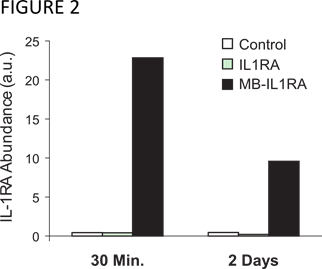Session Information
Date: Tuesday, November 15, 2016
Title: Metabolic and Crystal Arthropathies I: Mechanisms of Disease
Session Type: ACR Concurrent Abstract Session
Session Time: 4:30PM-6:00PM
Background/Purpose: A primary challenge for intra-articular delivery of protein and peptide therapies has been their short residence time in the joint tissues. The IL-1 receptor antagonist (IL1RA) could be therapeutic for treating local joint inflammation in monoarticular gout flare, osteoarthritis flare, or post-ACL injury. However, it has been limited by its short half-life in the joint, and previous attempts to prolong its residence time have led to decreased potency. A novel strategy for tissue-targeted local delivery involves fusion of a matrix-binding domain that binds to charged proteoglycans within the extracellular matrix. We describe here the generation of a matrix-binding interleukin-1 receptor antagonist (MB-IL1RA) fusion without loss of activity.
Methods: The matrix binding peptide is 21 amino acid sequence derived from the heparin-binding domain of HB-EGF. The MB-IL1RA fusion protein was expressed in E. coli and purified to homogeneity. Activity was tested in a cell-based assay using IL-1 to stimulate an NF-kB-driven luciferase reporter. Retention in articular cartilage tissue was tested in newborn bovine cartilage tissue explants. After incubation of either anakinra or MB-IL1RA with the tissue, the cartilage was washed into medium with no drug and assayed via Western analysis for drug remaining in the tissue.
Results: The 50% inhibitory concentrations (IC50s) of MB-IL1RA and anakinra were determined in the NFkB reporter cells in the presence of 5 ng/ml interleukin-1β, yielding IC50s of 175 pM ± 23 pM for anakinra and 152 pM ± 26 pM for MB-IL1RA (mean of 9 experimental repeats; a representative run is shown in Figure 1).
After wash-out of bovine cartilage explant disks for 30 min., IL-1RA (anakinra) was undetectable in the tissue by Western analysis (densitometric analysis shown in Figure 2). In contrast, the MB-IL1RA fusion protein was robustly detectable within the tissue even after two days of wash-out in plain medium.
Conclusion: The novel therapeutic fusion protein MB-IL1RA allows delivery of an IL-1 inhibitor to the articular cartilage and extended residence time within the tissue, while retaining full potency of the inhibitor. MB-IL1RA is a candidate therapeutic for IA administration to treat local inflammation in the joint in acute flares of gout and OA.
To cite this abstract in AMA style:
Pancoast J, Lee R, Patwari P. Development of a Matrix-Binding Interlukin-1 Receptor Antagonist Fusion Protein for Extended Retention in the Joint Tissues [abstract]. Arthritis Rheumatol. 2016; 68 (suppl 10). https://acrabstracts.org/abstract/development-of-a-matrix-binding-interlukin-1-receptor-antagonist-fusion-protein-for-extended-retention-in-the-joint-tissues/. Accessed .« Back to 2016 ACR/ARHP Annual Meeting
ACR Meeting Abstracts - https://acrabstracts.org/abstract/development-of-a-matrix-binding-interlukin-1-receptor-antagonist-fusion-protein-for-extended-retention-in-the-joint-tissues/


